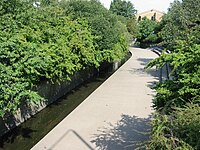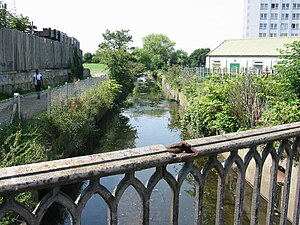River Rom: Difference between revisions
Created page with 'right|thumb|300px|The River Rom or Beam at Dagenham The '''River Rom''', also in places known as the '''River Beam''', is a river in Essex which…' |
|||
| Line 54: | Line 54: | ||
{{DEFAULTSORT:Rom}} | {{DEFAULTSORT:Rom}} | ||
[[Category:Rivers of Essex]] [[Category:Underground rivers of Essex]] [[Category:Tributaries of the River Thames]] | [[Category:Rivers of Essex|Rom]] [[Category:Underground rivers of Essex|Rom]] [[Category:Tributaries of the River Thames|Rom]] | ||
Latest revision as of 09:17, 27 May 2017

The River Rom, also in places known as the River Beam, is a river in Essex which becomes a tributary of the River Thames. It flows through the suburbs which characterise south-western Essex, above ground and underground, flowing through channels underneath Romford in the north.
Course
The river rises to the north of Romford at Bournebridge in Essex at a point where the Bourne Brook and other small streams meet. It flows through Romford underground in a man-made channel.
To the south of the town centre the Rom flows under Roneo Corner. At Eastbrookend Country Park it is joined by a tributary, the Ravensbourne, which rises in Ardleigh Green and flows through Emerson Park and Harrow Lodge Park.[1] The Rom then continues under the name of the River Beam and reaches the River Thames near the Ford Motor Company Works.
The Beam Valley comprises 182 acres of land running north along the River Beam from the near the Ford Motor Works. The valley also includes various historical features including tank traps, pillboxes and a section of the old Romford Canal.[2]
Name

The name 'River Rom' is a back-formation from the name of the town of Romford, which is located on a crossing of the river.[3] The name 'Romford' is first recorded in 1177 as Romfort, which is formed from 'rum' and 'ford' and means "the wide or spacious ford".[3] The name of the river is first recorded in the 13th century as le Markediche, meaning 'boundary ditch' and referring to the ancient boundary between the parishes of Dagenham and Hornchurch. The more recent name of River Beam originated from an early bridge over the river, consisting of a beam of wood.[3]
Wildlife and Environment

The Rom rises in the north western part of Havering and here it has been designated as a Site of Importance for Nature Conservation[4]
The river contains unbranched bur-reeds (Sparganium erectum and Sparganium emersum) and fool's watercress (Apium nodiflorum), and supports water voles, kingfishers and reed buntings; the surrounding farmland also has lapwings and golden plover in winter.
Apart from the actual river environs, the Site of Importance for Nature Conservation also includes Foreberry wood through which the river Rom runs. This contains both Pedunculate Oak and Hornbeam coppice.
Also in the upper parts of the river is another Site of Importance for Nature Conservation where the river flows through King George Playing Field in Romford.[5]
Further downstream, the Beam Valley is a mixture of woodlands, acid grassland, ponds and marsh areas and is a haven for many types of wildlife. There are plans to develop the area to improve the conservation interest and to create new opportunities for recreation and education. The River Beam is home to the rare water vole, while the grassland in the valley contains some uncommon plants.[6]
References
- ↑ A History of the County of Essex: Volume 7 1978]
- ↑ Barking and Dagenham Country Parks and Nature Reserves - The Beam Valley
- ↑ 3.0 3.1 3.2 Mills, D., Oxford Dictionary of London Place Names, (2000)
- ↑ "River Rom in North-West Havering". Sites of Borough Importance - Grade 2. London Borough of Havering/Greater London Authority. 2007-09-10. http://www.havering.gov.uk/index.aspx?articleid=4452. Retrieved 2009-05-20.
- ↑ "River Rom at King George's Playing Fields". Sites of Borough Importance - Grade 2. London Borough of Havering/Greater London Authority. 2007-09-10. http://www.havering.gov.uk/index.aspx?articleid=4475. Retrieved 2009-05-20.
- ↑ London Wildweb